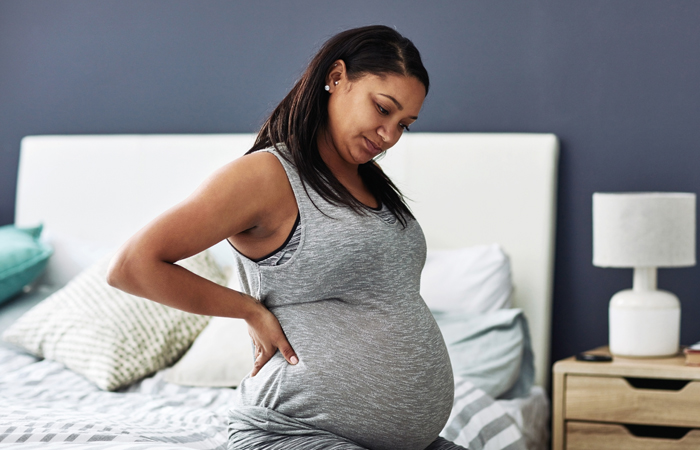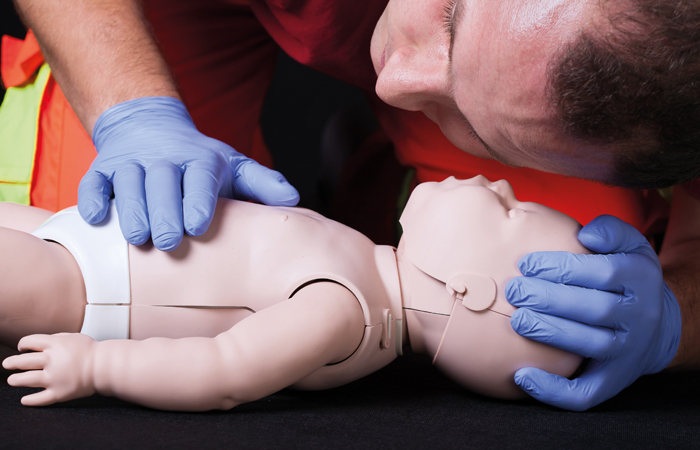Talking pregnancy in the pharmacy
In Conditions
Follow this topic
Bookmark
Record learning outcomes
Preparing for the arrival of a baby can be as stressful as it is exciting, but pharmacy teams can be on hand to offer parents-to-be tips, advice and an all-important listening ear to help them get ready for B-Day and beyond
Although much focus is placed on the time when bump turns to baby, so much has already changed for mums-to-be during their pregnancy and there’s a lot for them and their partners to get their heads around.

Throughout the whole process from pre-conception planning and pregnancy problems to perinatal mental health and keeping their little human happy and healthy, pharmacy teams can offer parents a much-needed pillar of support, providing advice, reassurance and signposting during these new and exciting times.
Quality over quantity
When it comes to pregnancy, ‘eating for two’ has been dubbed a myth by health organisations such as the Royal College of Obstetricians and Gynaecologists. Instead, the focus of pre- and post-conception nutrition should be on quality over quantity. It is important for women to be at, and maintain, a healthy weight when trying to get pregnant and whilst pregnant. “Ensuring that you are healthy when trying for a baby is really important, as this not only influences your own health and fertility, but can also affect your growing baby, if you do get pregnant,” says Alex White, nutrition scientist at the British Nutrition Foundation.
Women should try to eat a varied, healthy and balanced diet including wholegrain foods, fruit and vegetables and oily fish. “Oily fish is important, as it rich in long-chain omega-3 fatty acids, required for the development of your baby’s brain and eyes,” explains Alex.
As well as diet, nutritional supplements also have a role to play in supporting a baby’s development. “Taking a folic acid supplement is important before you become pregnant and during the first 12 weeks of pregnancy. For most women, a daily folic acid supplement of 400 micrograms is recommended, as this has been shown to reduce the risk of having a baby with a neural tube defect – problems affecting the baby’s spine and neural tubes, such as spina bifida,” Alex adds.
Other nutrients such as iron and vitamin D are also important and can be included in a diet using supplements, if necessary, but Alex says it is important that women pick a multivitamin or mineral supplement that are specifically designed for pregnancy. This is because some vitamins, such as vitamin A, should be avoided in pregnancy as they can cause harm to the baby.
When it comes to pregnancy, ‘eating for two’ has been dubbed a myth
Common pregnancy complaints
Before baby arrives, it is important for mums to be as comfortable as possible and pharmacy teams can help them manage pregnancy side effects.
Constipation
During pregnancy, the body starts producing more progesterone, which causes the bowels to relax and can create blockages. Some women may also suffer from constipation as a side effect of some iron supplements. A diet high in fibrous foods may help get things moving again. Foods high in fibre include wholegrain cereals, pasta and bread; nuts and seeds; vegetables such as broccoli and carrots; and fruit such as oranges and berries. In addition, drinking plenty of water and gentle exercise can help.
Bladder weakness
Throughout pregnancy, the muscles in the pelvic floor soften to help with childbirth. Additional pressure is also put on the bladder and pelvic floor muscles from the growing baby; this combination can lead to stress urinary incontinence. Pharmacy teams can recommend pregnant women practise pelvic floor exercises to help try and strengthen the pelvic floor muscles. These muscles – felt when stopping the flow of urine when going to the toilet – can be strengthened by squeezing them 10-15 times a day, each for a few seconds. Women can increase this number but should be careful not to overdo it.
Indigestion
This burning issue can happen at any point during pregnancy, but often occurs after 27 weeks. Indigestion can be due to hormonal changes, or even the position of the baby if it is pressing against the stomach. Symptoms can appear after eating or drinking and may include a burning sensation in the chest, feeling bloated or sick and bringing up food. Eating healthy, small meals can help. Caffeine and certain foods, such as those that are rich, spicy or high in fat, should be avoided.
Antacids, which help to neutralise stomach acid, may be suitable, although all pregnant women suffering from indigestion should be referred to the pharmacist. Women taking iron supplements should not take them simultaneously with antacids as antacids stop iron being absorbed.
Morning sickness
Approximately eight to 10 women experience nausea or vomiting, known as morning sickness, in the initial stages of pregnancy. Sickness can occur at any time of the day and not just in the morning as the name would infer. It usually passes for most women by weeks 16 to 20, but it can last longer.
There is no specific treatment available, but pharmacy teams can recommend some tips that may ease the sickness. This includes, getting enough rest, eating small frequent meals, avoiding smells that cause nausea, eating cold or plain food and drinking plenty of water. If sickness ensues, anti-sickness medication may be recommended by a GP. Excessive nausea and vomiting is known as hyperemesis gravidarum and often requires hospital treatment.
Back pain
A growing baby can often pull the spine forwards, putting a strain on the lower back and causing back pain for pregnant women. Wearing flat shoes, sitting up straight, keeping an eye on posture, avoiding lifting heavy objects and taking warm baths can help to relieve the ache. Some forms of exercise, such as yoga and Pilates designed for pregnancy, can help and there are also maternity support belts available, if necessary, which help to relieve lower back tension and support the stomach.

Stretch marks
Women often get stretch marks when they are pregnant because the skin stretches and can break as the baby gets bigger. Stretch marks appear as brown, red, purple or pink lines; they may be itchy initially as the skin starts to thin, but they do not cause any health issues. They usually appear on the stomach and can also appear on the thighs and breasts. After the baby is born, they tend to fade, but do not usually disappear completely. Women who gain more weight during pregnancy are more susceptible, so it is important to eat a healthy, balanced diet to maintain a healthy weight.
There are products available that contain ingredients such as hyaluronic acid and retinol, which may help make stretch marks fade, but there are no treatments that will certifiably remove them. It is important to note that retinol treatments should not be used during pregnancy.
Essential abstention
If a pregnant woman drinks alcohol or smokes, in effect, her baby does too. Avoiding both is highly recommended for women trying to get pregnant, and especially throughout pregnancy, as both can cause long-term harm to babies. Pharmacy teams can signpost customers to further information about why smoking and alcohol causes harm, as well as smoking cessation services to help women quit.
• Alcohol consumption
Babies cannot process alcohol like adults, especially as the liver develops at a later stage in pregnancy. Alcohol can cause problems such as poor growth and learning and behavioural problems. Drinking in excess can also cause foetal alcohol syndrome, causing life-long damage to the baby’s body including to the brain cells and spinal cord. In severe cases, miscarriage can occur.
Signposting suggestion: Drinkaware
• Smoking
Smoking whilst pregnant can prevent nutrients and oxygen reaching the baby in the womb. This can cause a variety of problems such as stillbirth, miscarriage, ectopic pregnancy, birth abnormalities and stunted growth. Babies born to mothers who smoked during pregnancy are also at higher risk of developing asthma, behavioural problems and sudden infant death syndrome (SIDS).
Signposting suggestion: NCT: smoking during pregnancy.
If a pregnant woman drinks alcohol or smokes, in effect, her baby does too
When bump becomes baby
Once a baby has appeared on the scene, there are countless different concerns parents may have about the little one’s health and wellbeing, such as first aid and feeding.
Baby first aid
Many people may not be aware that specific first aid for babies and children exists, or is any different to that for adults. But knowing the basics can not only help to lighten the load on an over-stretched NHS, in some cases it has the potential to mean the difference between life and death.
Jenni Dunman is the founder of Daisy First Aid – an organisation that provides two-hour baby first aid training for parents and child carers – see right. Here are some of her top tips for emergency situations.
- Remember, choking is silent: “When a baby or child is choking, they can’t cough, breathe, talk or cry; choking is silent,” explains Jenni. “If a child is gagging then they can breathe. They might cough, but coughing is normal. We do not intervene if a child is coughing because they are breathing.” According to the NHS, if choking is suspected, parents should avoid trying to remove the object as this could risk pushing it further down the throat. If the child is conscious, back blows may help to dislodge the blockage, but immediate emergency assistance should be sought.
- CPR is breathing first, then heart: “The main difference when a baby or a child stops breathing [compared to an adult] is that it is more likely to be a breathing problem rather than a heart problem. With an adult it is more likely to be their heart,” says Jenni. “When we are doing CPR on a baby or a child, we start CPR with five rescue breaths first, whereas with an adult we would start chest compressions first.”
- Red flags for meningitis: “The symptoms of meningitis can be very similar to the symptoms of flu or colds, but if a child has a temperature that you can’t reduce; if a child isn’t eating, drinking or going to the toilet, that would be a red flag,” Jenni explains. “We also talk about meningitis rash, what it looks like and why not every child with meningitis gets a rash. We mustn’t wait for the rash.”
According to the NHS, other common symptoms of meningitis include cold hands and feet, vomiting, confusion, breathing quickly, muscle and joint pain, headache, a stiff neck, a dislike of bright lights, being very sleepy or difficult to wake and seizures.
If the meningitis is suspected, parents should call 999 for an ambulance or go to the nearest A&E as a matter of urgency. The condition can get worse very quickly so immediate care is crucial. The message is: trust your instincts and do not wait until a rash develops.
To read more about Jenni and Daisy First Aid, see Time Out With... Jenni Dunham.

Feeding problems
Feeding can be a difficult time for parents, especially as around 50 per cent of infants under one year of age will experience at least one feeding problem. Pharmacy teams can help to reassure parents that problems are common and offer some potential solutions.
Colic
Colic is one of the most common infant feeding problems, affecting an estimated five to 20 per cent of infants. “When a baby is suffering from colic it can be traumatic for the parents, who may feel like they are doing something wrong or that they haven’t established a relationship with their baby,” says Zoë Ellis, head of consumer medical affairs, Danone Specialised Nutrition UK & Ireland. “It is important to reassure the parents that there is nothing medically wrong with the baby and it is a phase that will pass over the course of three to four months.”
Zoë has some advice for pharmacy teams to pass onto parents whose babies are experiencing colic:
- Ensure they use an upright feeding position and adequate burping post-feed
- Suggest they hold the baby during crying episodes or give them gentle motion such as pushing them in a pram
- If bottle feeding, try a faster flow teat with larger or more holes
- Recommend they try using calming white noise such as the sound of a vacuum cleaner or hairdryer
- If crying is proving intolerable for the parent, let them know that it is important for them to take breaks. CRY-SIS – a support group for families – is available to provide further advice and reassurance.
Constipation
Around 15 per cent of babies are affected by constipation before the age of one and the condition can often coincide with other issues such as colic. “There can be many different symptoms and signs for parents to look out for, and pharmacy teams to be aware of, including if a baby doesn’t poo at least three times a week, has painful or hard bowel movements, poor appetite and foul-smelling wind or stools. The main behavioural symptoms of constipation are poor appetite and lack of energy,” explains Zoë.
If a baby has these symptoms, Zoë suggests lying them down on their back and moving their legs in a cycling motion, or a gentle tummy massage. “For formula-fed babies, you can also try giving additional cooled, boiled water between normal feeds,” she adds.
Allergies and intolerance
The symptoms of lactose intolerance and a cows’ milk allergy (CMA) can often be confused so it is important for pharmacy teams to become familiar with their subtle differences.
Lactose intolerant describes a baby that cannot digest lactose – the sugar found in breast milk. CMA is an immunological hypersensitivity to one or more of the proteins found in milk.
“There are symptoms which can occur with CMA, but not with lactose intolerance,” says Zoë. “The symptoms for lactose intolerance are purely gastrointestinal, for example abdominal pain, diarrhoea and bloating. With CMA, symptoms can be gastrointestinal, or they can be respiratory – for example wheezing, rhinitis – or skin-related – for example urticaria (hives) – and, in some severe cases, can lead to anaphylaxis. Therefore, symptoms from two or more of these organ systems is suggestive of CMA rather than lactose intolerance.”
Perinatal mental health
The mental health charity Mind describes perinatal mental health problems as ones that are experienced “any time from becoming pregnant up to a year after you give birth”.
Up to 20 per cent of new and expectant mothers are thought to be affected by perinatal mental health problems. This can be a new mental health issue or one experienced previously, and partners can also be affected. The most common forms include perinatal depression, anxiety, obsessive compulsive disorder (OCD), postpartum psychosis and post-traumatic stress disorder (PTSD).
This topic continues to become increasingly less stigmatised, yet some women can often feel guilty for having perinatal mental health problems. Pharmacy teams can reassure them that they are not to blame, that many women experience feelings such as these and that mental health support is available. Find more information and support on Mind: Postnatal depression and perinatal mental health.
